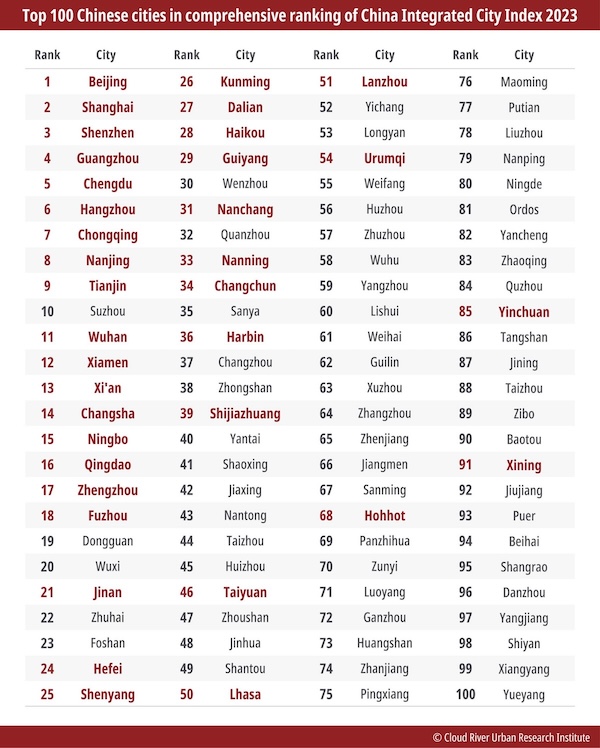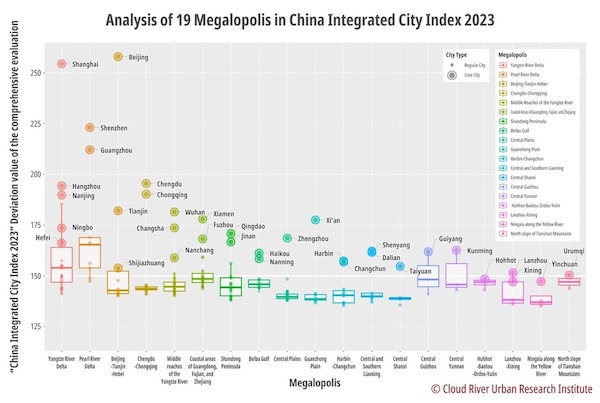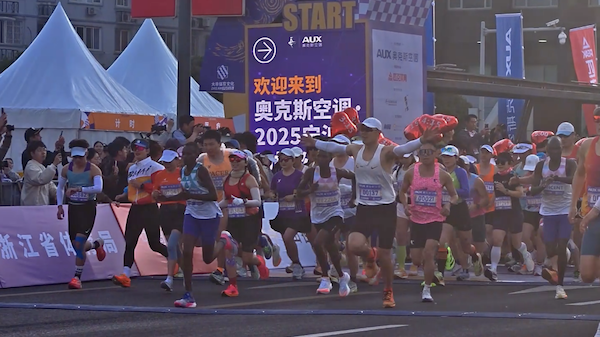China Integrated City Index 2023: An outlook for China's megalopolises
Cloud River Urban Research Institute released the China Integrated City Index 2023 at a seminar held in Tokyo, Japan, on Dec1, 2024. The event was co-hosted by the Counselors' Office of the People's Government of Beijing Municipality and Cloud River Urban Research Institute.
According to the index, Beijing retained its position as the top-ranked city for the eighth consecutive year in the comprehensive ranking, followed by Shanghai in second place and Shenzhen in third. Guangzhou, Chengdu, Hangzhou, Chongqing, Nanjing, Tianjin, and Suzhou ranked 4th to 10th, respectively. Cities ranked 11th to 30th were Wuhan, Xiamen, Xi'an, Changsha, Ningbo, Qingdao, Zhengzhou, Fuzhou, Dongguan, Wuxi, Jinan, Zhuhai, Foshan, Hefei, Shenyang, Kunming, Dalian, Haikou, Guiyang, and Wenzhou.

Top 100 Chinese cities in comprehensive ranking of China Integrated City Index 2023
Scholars and experts weighed in on the index at the seminar.
Zhou Muzhi, head of Cloud River Urban Research Institute and professor at Tokyo Keizai University
This index, the eighth of its kind since its inception in 2016, is a review and analysis of the development of major megalopolises in China.
China's 11th Five-Year Plan (2006-10) introduced the strategy for the development of major megalopolises, signaling a significant policy shift that accelerated China's urbanization. Thus how to evaluate the development of China's 19 major megalopolises became an important field of research.
Given the varied and often inconsistent criteria used to define first-tier, second-tier, and third-tier cities, a new classification system was introduced in 2023 based on the deviation values of cities' rankings in the index. According to the system, Chinese cities are categorized as first-tier, quasi-first-tier, second-tier, and third-tier. Using boxplot and bee swarm plot analyses, the index evaluates 223 Chinese cities in the 19 megalopolises, clearly illustrating their distribution and disparity across different tiers in each cluster.

Analysis of 19 megalopolises in China Integrated City Index 2023
The comprehensive ranking deviation value is calculated as the sum of deviation values across three dimensions: economy, environment, and society, with a total score of 300. Cities with deviation values exceeding 200 are defined as first-tier cities, including Beijing, Shanghai, Shenzhen, and Guangzhou. These cities are concentrated in the three major megalopolises of the Yangtze River Delta, Pearl River Delta, and the Beijing-Tianjin-Hebei region. This underscores the leading role of these clusters.
Cities with deviation values between 175 and 200 are classified as quasi-first-tier cities. There are nine such cities. These cities are located in megalopolises such as the Yangtze River Delta, the Beijing-Tianjin-Hebei region, the Chengdu-Chongqing economic circle, the middle reaches of the Yangtze River, coastal areas of Guangdong, Fujian, Zhejiang provinces, and the Guanzhong Plain. Second-tier cities, with deviation values ranging from 150 to 175, include 43 ones and are widely distributed across China. Third-tier cities, with deviation values below 150, include 241 ones, among them are core cities such as Yinchuan, Xining, and Hohhot.
The first criterion for evaluating megalopolises is the number and tier of their core cities. The Yangtze River Delta has the largest number of core cities but includes only one first-tier city, namely Shanghai. Similarly, the Beijing-Tianjin-Hebei region has only Beijing as a first-tier city. The Pearl River Delta has two first-tier cities, Shenzhen and Guangzhou, but their deviation values are outperformed by Beijing and Shanghai.
The second criterion is the overall development level of cities in the cluster. In boxplot analysis, the horizontal line within the box represents the median of the sample, the top of the box indicates the upper quartile (75%), and the bottom indicates the lower quartile (25%), with the box encompassing the distribution of 50% of the samples. Bee swarm plots, which display individual data points, combined with boxplots, effectively show the position of each sample and the overall distribution pattern. From this analysis, it is evident that among the three major clusters, the Pearl River Delta demonstrates the best overall development, followed by the Yangtze River Delta, while most non-core cities in the Beijing-Tianjin-Hebei region show weaker development.
Yang Weimin, deputy director of the Economic Affairs Committee of the 13th Chinese People's Political Consultative Conference
Professor Zhou and I have collaborated for many years. In 2001, he published "Urbanization: The Main Theme of China's Modernization," where he proposed the development strategy for major megalopolises in China. Later, we co-authored "The Third Thirty Years." In 1999, we introduced the urbanization strategy, which later evolved into the concept of "urbanization of towns." During the 11th Five-Year Plan period, when I served as director general of the Department of Development Planning of the National Development and Reform Commission, I proposed the strategy of megalopolises. After reading Zhou's book, I became fully convinced of the megalopolis's development concept.
I have always kept a close watch on the China Integrated City Index. I compared the index to a health check-up report for Chinese cities. Now, some cities and departments have followed suit and created their own health check-up reports. However, these reports often focus more on urban construction, paying insufficient attention to economic aspects. This is why the China Integrated City Index stands out — it validates economic principles on a solid foundation.
Therefore, using the index to objectively evaluate the development of megalopolises is of paramount importance.
Qiu Xiaohua, professor at City University of Macau and former head of the National Bureau of Statistics
I think the index has four distinctive features.
First, the index is highly comprehensive, with three primary categories, nine secondary categories, and 27 subcategories. The index encompasses economic, social, and environmental dimensions, with cultural aspects included in the social dimension. This means the index evaluates economic development, social advancement, ecological sustainability, and cultural progress, making it a well-rounded assessment tool.
Second, the index is not merely a qualitative evaluation; it places significant emphasis on quantitative analysis. Of the 878 datasets used, one-third comes from statistical data, one-third from internet data, and one-third from satellite remote sensing data. This approach maximizes the use of all available data sources to create a comprehensive quantitative assessment. By employing a multimodal quantitative method, the index provides a credible ranking for 297 Chinese cities at or above prefecture level, making it highly convincing and widely accepted.
Third, it is an ongoing effort. The research on the China Integrated City Index has lasted for over a decade. A one-off evaluation holds limited significance, but continuous tracking yields profound insights. This continuity makes the index strategically significant, offering valuable guidance for governments, businesses, and ordinary people. The index offers accessible and valuable data to inform national strategy formulation, corporate business planning, and individual choices about where to live and work. It serves as a "dictionary of cities" and helps better understand urban development in China.
Fourth, it adopts scientific methodologies. Effective index evaluation requires comparability, accessibility, measurability, and observability, all of which demand a robust scientific methodology. Professor Zhou's application of a scientific, quantitative, intuitive, and continuous evaluation framework ensures that the results are credible, realistic, and reliable.
Li Guoping, counselor of the Beijing municipal government and director of Beijing Development Institute at Peking University
It is a great honor to participate in the seminar. As this topic is close to my research field, I have consistently referred to Professor Zhou's publications. I had accessed studies related to the China Integrated City Index through various channels. I find this index robust, both in its systematic design and in its comprehensive data support. The evaluation results it generates are indeed highly consistent with real-world observations.
Core cities play an increasingly leading role. While the Yangtze River Delta only has one first-tier city, it is supported by a group of quasi-first-tier cities. Its overall geography and various conditions have gained the Yangtze River Delta an advantage over the Pearl River Delta. Due to its larger scale, as well as its connection to the Yangtze River Economic Belt and the Chengdu-Chongqing economic circle, the region shows enormous potential.
What about Beijing? Its position as the top-ranked city is well-established. Its relationship with Tianjin and Hebei makes the coordinated development of the Beijing-Tianjin-Hebei region critically important. Beijing has strong capabilities in technological innovation, and if given full play, innovation will be a driving force for the Beijing-Tianjin-Hebei region. The key lies in effectively linking the industrial and innovation chains across Beijing, Tianjin, and Hebei, which are not as seamlessly connected as those in the Yangtze River Delta and the Pearl River Delta.
Zhou Qiren, professor at the National School of Development of Peking University
Concentration and clustering mean people crowd into already congested areas, driven by the increasing demand for proximity to economic activities. Crowding causes numerous problems, but the benefits brought by crowding often outweigh the inconveniences. Moreover, the issues arising from crowding can be mitigated through urban planning and technological advancements. A densely populated area can be chaotic, but it can also be well-organized with proper management.
The foundational work of the index is commendable, but I suggest integrating the latest developments into Professor Zhou's next phase of research. With declining air travel costs, increasing cloud-based communication, and improved AI, is it still necessary for people to commute to city centers for work in the future? Nowadays, people can work remotely. This may even lead to prolonged vacancies in Shanghai's office buildings. The pandemic prompted people to explore new ways of communication, lifestyles, and production modes, each with difference space requirements.
The most critical question is: How are the world's most productive, dynamic, and innovative people working? What kind of spatial patterns are they creating?
Xu Lin, chairman of China-U.S. Green Fund and former director general of the Department of Development Planning of the National Development and Reform Commission
In my opinion, the China Integrated City Index can incorporate evaluations of urban governance, which is an essential variable. The governance model of a city has a significant impact on its comprehensive assessment.
I suggest the comparison of Chinese cities with their overseas counterparts could provide a framework for assessment, even if it is partially subjective. A well-governed, attractive city is inherently open, inclusive, and convenient. These qualities make a city more competitive.
Opinion articles reflect the views of their authors, not necessarily those of China.org.cn.

 China welcomes global travelers with open arms
China welcomes global travelers with open arms
 Kharitonova's running story in Ningbo
Kharitonova's running story in Ningbo
 Voices from starting line
Voices from starting line



